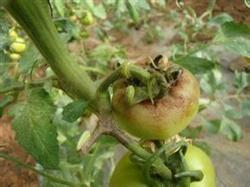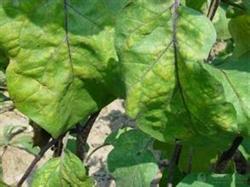How to Control physiological Diseases of Tomato

Physiological diseases often occur in the process of tomato cultivation, which have a great impact on the yield and quality. The most common are deformed fruit, hollow fruit, navel rot, fruit cracking, muscle rot, sunburn, poor coloring and so on. Deformed fruit. It mainly occurs in the period of flower bud differentiation and development. under low temperature, multi-fertilizer (especially excess nitrogen nutrition), sufficient water and light, excessive nutrition accumulation at the growing point, excessive division of developing flower bud cells and excessive number of carpels, multi-ventricular deformed fruits are formed due to the uneven development of carpels after flowering. The apical split or transverse split fruit in malformed fruit is mainly caused by poor conditions during flower bud development, which inhibit the transport of calcitonin to floral organ. In addition, pointed fruit is easy to be formed under the condition of malnutrition. In order to prevent the occurrence of deformed fruit, the temperature should not be controlled too low during the seedling period, and the water and nutrition must be adjusted properly. Empty fruit. There are two reasons for its occurrence: first, due to the influence of bad conditions during flowering, it can not be fertilized normally, there are no seeds in the fruit, and the placenta of the fruit is poorly developed, resulting in the formation of hollow fruit. Second, the use of growth-stimulating hormone, due to the concentration is too high, or in the bud stage treatment, easy to produce hollow fruit. The occurrence of hollow fruit can be avoided by artificial pollination and timely and appropriate use of hormone. Umbilical rot. The lack of calcium at the top of the fruit is the main cause of navel rot. There are three reasons for calcium deficiency in fruits: (1) soil calcium deficiency, (2) high soil temperature, soil dryness, and high concentration of soil solution, especially too much potassium, magnesium and ammonia nitrogen, which affect the absorption of calcium by plants. (3) under the condition of high temperature, calcium moves slowly in plants. To prevent navel rot, acid soil should be regulated by lime, pay attention to maintain the appropriate concentration of soil during fertilization, properly control the amount of ammonia nitrogen, try to avoid excessive soil temperature and drastic changes of soil temperature, and often keep the soil moist during the result period. 0.5% calcium chloride can also be used to spray new leaves and emerging inflorescences to prevent navel rot. Dehiscent fruit. There are many types of fruit dehiscence, some with sepals as the center, concentric circular fissures, some radiate fissures, and some irregular lateral dehiscence or split bark. In general, large fruit varieties and mature fruits are easy to crack, especially in the early stage of fruit hypertrophy, under the conditions of high temperature, strong light and soil drying, the shoulder epidermis of the fruit is aging, and the fruit expands rapidly and produces cracking fruit in case of rainfall or a large amount of irrigation. In order to prevent fruit cracking, in addition to selecting anti-cracking fruit varieties, the fruit should be avoided from being exposed to strong light, and the soil moisture should be maintained during the fruiting period. Boron fertilizer can also be applied to enhance the plasticity of the pericarp. Muscle rot. It is divided into browning type and albino type. The vascular bundles and surrounding tissues of the browning fruit browned, and the peel and wall of the albino fruit hardened and whiten. Both types of diseases are caused by a variety of adverse conditions. In order to prevent gluten rot, suitable conditions for normal growth of tomato should be created, potassium fertilizer should be added appropriately, and nitrate nitrogen should be used as the main nitrogen fertilizer. Sunburn sickness. In the summer high temperature season, due to the strong light, the temperature of part of the fruit shoulder rises, part of the tissue burns and dies, resulting in sunburn disease. Varieties with small leaf area, exposed fruit or thin pericarp are prone to disease. In order to prevent sunburn, the sunburn of the fruit should be avoided in the fruiting period, and the cone frame or herringbone frame should be used. When binding the seedlings, the ear should be placed in the shade of the leaves in the rack, and proper application of potash fertilizer can enhance its resistance. Poor coloring. After the fruit is fully enlarged, its coloring is not only related to temperature, but also closely related to the supply of nutrients. When nitrogen, potassium and boron were deficient, the fruit was poorly colored, and when potassium was deficient, the vascular bundles of the fruit were easy to be lignified, and the shoulder of boron deficient fruit remained green. During the peak period of fruit expansion, the lack of moisture in the fruit will also make the pericarp reticulate, pulp hardened and poor coloring. Therefore, it is necessary to control the temperature and moisture in production and pay attention to balanced nutrition.
- Prev

How to identify tomato late blight
Late blight: the whole growth period and leaves, stems and fruits can be damaged, especially leaves and green fruits. The disease of seedlings generally appeared dark green watery spots from the leaves, and then extended to the stem, showing dark brown rot near the petiole. with the development of the disease, the base of the young stem was waterlogged constricted and the plant wilted and collapsed. The disease in the adult stage starts from.
- Next

How to Control the Fertilizer damage of Tomato
Leaf mildew is a major disease of tomato in greenhouse. It mainly harms leaves. Lack of light, poor ventilation and excessive humidity are the main causes of leaf mildew. The control method is to select disease-resistant varieties, such as Jingyan Jiafan No. 17 and so on. Strengthen the management of temperature and humidity, ventilate and reduce humidity in time. Balanced fertilization, formula fertilization.
Related
- Where is it suitable to grow horseradish in China? it is expected to see the middle altitude horseradish in Alishan.
- How to prevent tomato virus disease reasonably? (Control methods included)
- Many people like to plant towel gourd on the balcony. What are the main points of this method and management?
- What crops can chili peppers be mixed with?
- Fertilization techniques and matters needing attention in Tomato
- What are the grafting techniques for peach seedlings in spring?
- Harm and control methods of root swelling disease of Chinese cabbage
- What are the pests of sweet potatoes? How to prevent and cure it?
- Symptoms, causes and Control methods of navel Rot in Tomato
- The cause of "Cucumber rotten bibcock" in Farmers' planting Cucumber and its Control Plan

